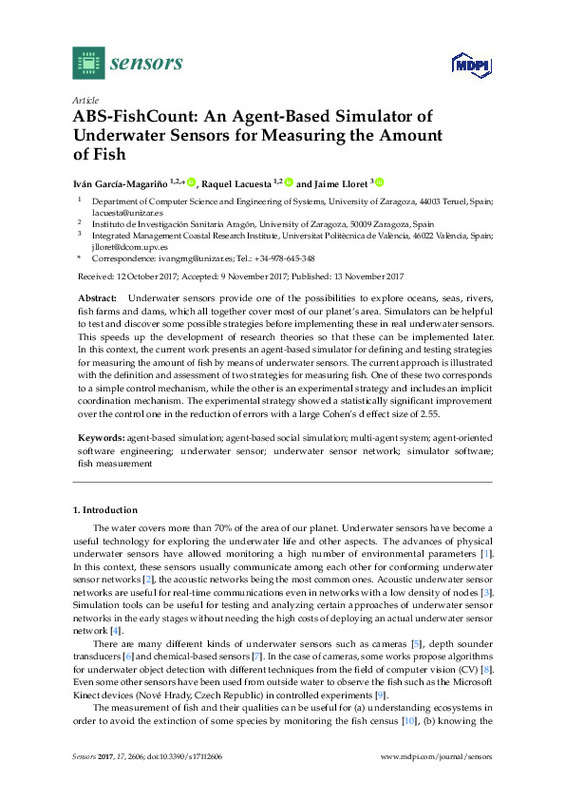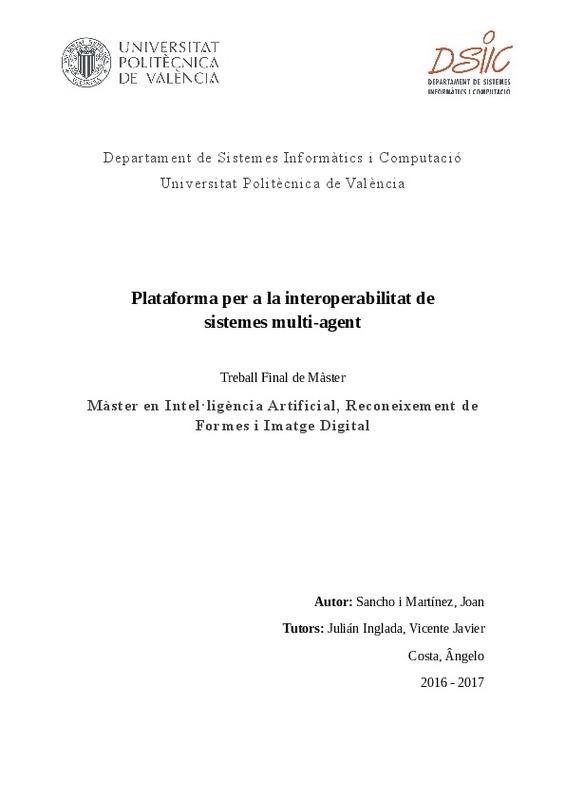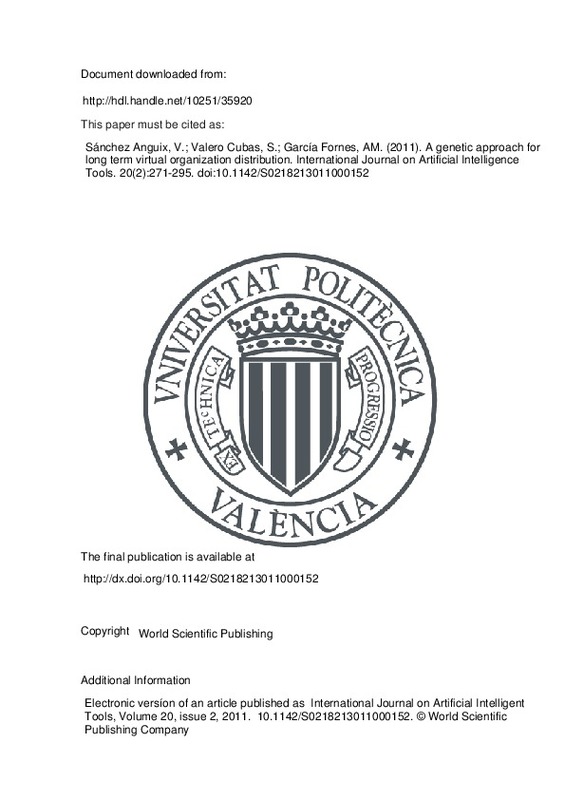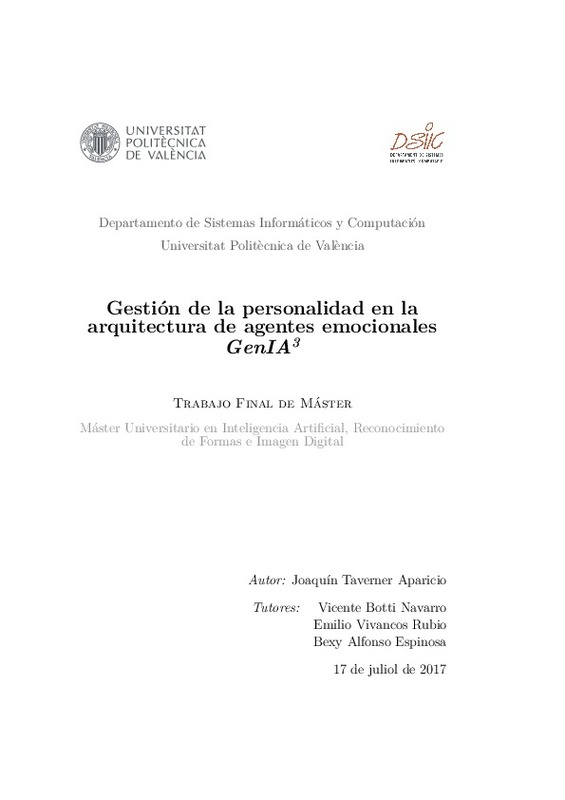Lloret, J. (2013). Underwater Sensor Nodes and Networks. Sensors, 13(9), 11782-11796. doi:10.3390/s130911782
Akyildiz, I. F., Pompili, D., & Melodia, T. (2005). Underwater acoustic sensor networks: research challenges. Ad Hoc Networks, 3(3), 257-279. doi:10.1016/j.adhoc.2005.01.004
Santos, R., Orozco, J., Micheletto, M., Ochoa, S., Meseguer, R., Millan, P., & Molina, C. (2017). Real-Time Communication Support for Underwater Acoustic Sensor Networks. Sensors, 17(7), 1629. doi:10.3390/s17071629
[+]
Lloret, J. (2013). Underwater Sensor Nodes and Networks. Sensors, 13(9), 11782-11796. doi:10.3390/s130911782
Akyildiz, I. F., Pompili, D., & Melodia, T. (2005). Underwater acoustic sensor networks: research challenges. Ad Hoc Networks, 3(3), 257-279. doi:10.1016/j.adhoc.2005.01.004
Santos, R., Orozco, J., Micheletto, M., Ochoa, S., Meseguer, R., Millan, P., & Molina, C. (2017). Real-Time Communication Support for Underwater Acoustic Sensor Networks. Sensors, 17(7), 1629. doi:10.3390/s17071629
Das, A. P., & Thampi, S. M. (2017). Simulation Tools for Underwater Sensor Networks: A Survey. Network Protocols and Algorithms, 8(4), 41. doi:10.5296/npa.v8i4.10471
Kawahara, R., Nobuhara, S., & Matsuyama, T. (2016). Dynamic 3D capture of swimming fish by underwater active stereo. Methods in Oceanography, 17, 118-137. doi:10.1016/j.mio.2016.08.002
Schaner, T., Fox, M. G., & Taraborelli, A. C. (2009). An inexpensive system for underwater video surveys of demersal fishes. Journal of Great Lakes Research, 35(2), 317-319. doi:10.1016/j.jglr.2008.12.003
Shinoda, R., Wu, H., Murata, M., Ohnuki, H., Yoshiura, Y., & Endo, H. (2017). Development of an optical communication type biosensor for real-time monitoring of fish stress. Sensors and Actuators B: Chemical, 247, 765-773. doi:10.1016/j.snb.2017.03.034
Chen, Z., Zhang, Z., Dai, F., Bu, Y., & Wang, H. (2017). Monocular Vision-Based Underwater Object Detection. Sensors, 17(8), 1784. doi:10.3390/s17081784
Saberioon, M. M., & Cisar, P. (2016). Automated multiple fish tracking in three-Dimension using a Structured Light Sensor. Computers and Electronics in Agriculture, 121, 215-221. doi:10.1016/j.compag.2015.12.014
Pais, M. P., & Cabral, H. N. (2017). Fish behaviour effects on the accuracy and precision of underwater visual census surveys. A virtual ecologist approach using an individual-based model. Ecological Modelling, 346, 58-69. doi:10.1016/j.ecolmodel.2016.12.011
Burget, P., & Pachner, D. (2005). FISH FARM AUTOMATION. IFAC Proceedings Volumes, 38(1), 137-142. doi:10.3182/20050703-6-cz-1902.02113
Simon, Y., Levavi-Sivan, B., Cahaner, A., Hulata, G., Antler, A., Rozenfeld, L., & Halachmi, I. (2017). A behavioural sensor for fish stress. Aquacultural Engineering, 77, 107-111. doi:10.1016/j.aquaeng.2017.04.001
Petreman, I. C., Jones, N. E., & Milne, S. W. (2014). Observer bias and subsampling efficiencies for estimating the number of migrating fish in rivers using Dual-frequency IDentification SONar (DIDSON). Fisheries Research, 155, 160-167. doi:10.1016/j.fishres.2014.03.001
Garcia, M., Sendra, S., Lloret, G., & Lloret, J. (2011). Monitoring and control sensor system for fish feeding in marine fish farms. IET Communications, 5(12), 1682-1690. doi:10.1049/iet-com.2010.0654
Lloret, J., Garcia, M., Sendra, S., & Lloret, G. (2014). An underwater wireless group-based sensor network for marine fish farms sustainability monitoring. Telecommunication Systems, 60(1), 67-84. doi:10.1007/s11235-014-9922-3
Bharamagoudra, M. R., Manvi, S. S., & Gonen, B. (2017). Event driven energy depth and channel aware routing for underwater acoustic sensor networks: Agent oriented clustering based approach. Computers & Electrical Engineering, 58, 1-19. doi:10.1016/j.compeleceng.2017.01.004
Gallehdari, Z., Meskin, N., & Khorasani, K. (2017). Distributed reconfigurable control strategies for switching topology networked multi-agent systems. ISA Transactions, 71, 51-67. doi:10.1016/j.isatra.2017.06.008
Jurdak, R., Elfes, A., Kusy, B., Tews, A., Hu, W., Hernandez, E., … Sikka, P. (2015). Autonomous surveillance for biosecurity. Trends in Biotechnology, 33(4), 201-207. doi:10.1016/j.tibtech.2015.01.003
García-Magariño, I., & Plaza, I. (2015). FTS-SOCI: An agent-based framework for simulating teaching strategies with evolutions of sociograms. Simulation Modelling Practice and Theory, 57, 161-178. doi:10.1016/j.simpat.2015.07.003
Cooke, S. J., Brownscombe, J. W., Raby, G. D., Broell, F., Hinch, S. G., Clark, T. D., & Semmens, J. M. (2016). Remote bioenergetics measurements in wild fish: Opportunities and challenges. Comparative Biochemistry and Physiology Part A: Molecular & Integrative Physiology, 202, 23-37. doi:10.1016/j.cbpa.2016.03.022
García, M. R., Cabo, M. L., Herrera, J. R., Ramilo-Fernández, G., Alonso, A. A., & Balsa-Canto, E. (2017). Smart sensor to predict retail fresh fish quality under ice storage. Journal of Food Engineering, 197, 87-97. doi:10.1016/j.jfoodeng.2016.11.006
Tušer, M., Frouzová, J., Balk, H., Muška, M., Mrkvička, T., & Kubečka, J. (2014). Evaluation of potential bias in observing fish with a DIDSON acoustic camera. Fisheries Research, 155, 114-121. doi:10.1016/j.fishres.2014.02.031
Rakowitz, G., Tušer, M., Říha, M., Jůza, T., Balk, H., & Kubečka, J. (2012). Use of high-frequency imaging sonar (DIDSON) to observe fish behaviour towards a surface trawl. Fisheries Research, 123-124, 37-48. doi:10.1016/j.fishres.2011.11.018
Cenek, M., & Franklin, M. (2017). An adaptable agent-based model for guiding multi-species Pacific salmon fisheries management within a SES framework. Ecological Modelling, 360, 132-149. doi:10.1016/j.ecolmodel.2017.06.024
Gao, L., & Hailu, A. (2011). Evaluating the effects of area closure for recreational fishing in a coral reef ecosystem: The benefits of an integrated economic and biophysical modeling. Ecological Economics, 70(10), 1735-1745. doi:10.1016/j.ecolecon.2011.04.014
Helbing, D., & Balietti, S. (2011). From social simulation to integrative system design. The European Physical Journal Special Topics, 195(1), 69-100. doi:10.1140/epjst/e2011-01402-7
Reynolds, C. W. (1987). Flocks, herds and schools: A distributed behavioral model. ACM SIGGRAPH Computer Graphics, 21(4), 25-34. doi:10.1145/37402.37406
Beltran, R. S., Testa, J. W., & Burns, J. M. (2017). An agent-based bioenergetics model for predicting impacts of environmental change on a top marine predator, the Weddell seal. Ecological Modelling, 351, 36-50. doi:10.1016/j.ecolmodel.2017.02.002
Berman, M., Nicolson, C., Kofinas, G., Tetlichi, J., & Martin, S. (2004). Adaptation and Sustainability in a Small Arctic Community : Results of an Agent-based Simulation Model. ARCTIC, 57(4). doi:10.14430/arctic517
Kadir, H. A., & Arshad, M. R. (2015). Cooperative Multi Agent System for Ocean Observation System based on Consensus Algorithm. Procedia Computer Science, 76, 203-208. doi:10.1016/j.procs.2015.12.343
Trygonis, V., Georgakarakos, S., Dagorn, L., & Brehmer, P. (2016). Spatiotemporal distribution of fish schools around drifting fish aggregating devices. Fisheries Research, 177, 39-49. doi:10.1016/j.fishres.2016.01.013
De Kerckhove, D. T., Milne, S., & Shuter, B. J. (2015). Measuring fish school swimming speeds with two acoustic beams and determining the angle of the school detection. Fisheries Research, 172, 432-439. doi:10.1016/j.fishres.2015.08.001
Source Code of the Agent-Based Simulator of Underwater Sensors for Measuring the Amount of Fishes Called ABS-FishCounthttp://dx.doi.org/10.17632/yzmt73x8j8.1
Cossentino, M., Gaud, N., Hilaire, V., Galland, S., & Koukam, A. (2009). ASPECS: an agent-oriented software process for engineering complex systems. Autonomous Agents and Multi-Agent Systems, 20(2), 260-304. doi:10.1007/s10458-009-9099-4
García-Magariño, I., Palacios-Navarro, G., & Lacuesta, R. (2017). TABSAOND: A technique for developing agent-based simulation apps and online tools with nondeterministic decisions. Simulation Modelling Practice and Theory, 77, 84-107. doi:10.1016/j.simpat.2017.05.006
García-Magariño, I., Gómez-Rodríguez, A., González-Moreno, J. C., & Palacios-Navarro, G. (2015). PEABS: A Process for developing Efficient Agent-Based Simulators. Engineering Applications of Artificial Intelligence, 46, 104-112. doi:10.1016/j.engappai.2015.09.003
Rosenthal, J. A. (1996). Qualitative Descriptors of Strength of Association and Effect Size. Journal of Social Service Research, 21(4), 37-59. doi:10.1300/j079v21n04_02
[-]












